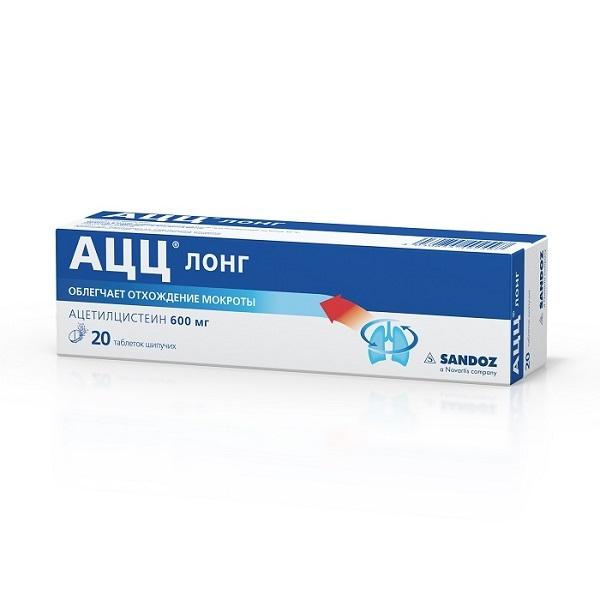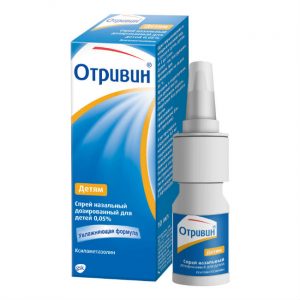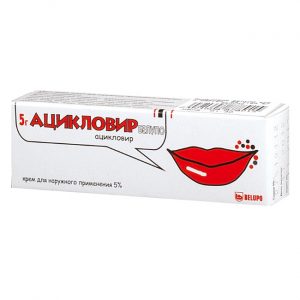Description
Latin name
ACC long
Release form
Effervescent tablets 600 mg
Primary packaging
For 6, 10 or 20 effervescent tablets in a polypropylene tube.
Secondary packaging
1 tube in a carton box along with instructions for use.
Pharmacological action
PHARMACODYNAMICS
Acetylcysteine is a derivative of the amino acid cysteine. It has a mucolytic effect, facilitates sputum discharge due to a direct effect on the rheological properties of sputum. The action is due to the ability to break the disulfide bonds of mucopolysaccharide chains and cause depolymerization of mucoproteins of sputum, which leads to a decrease in the viscosity of sputum. The drug remains active in the presence of purulent sputum. It has an antioxidant effect, based on the ability of its reactive sulfhydryl groups (SH-groups) to bind to oxidizing radicals and, thus, neutralize them. In addition, acetylcysteine promotes the synthesis of glutathione, an important component of the antioxidant system and chemical detoxification of the body. The antioxidant effect of acetylcysteine increases the protection of cells from the damaging effects of free radical oxidation, which is characteristic of an intense inflammatory reaction. With the prophylactic use of acetylcysteine, there is a decrease in the frequency and severity of exacerbations of bacterial etiology in patients with chronic bronchitis and cystic fibrosis.
PHARMACOKINETICS
Absorption is high. It is rapidly metabolized in the liver with the formation of a pharmacologically active metabolite – cysteine, as well as diacetylcysteine, cystine and mixed disulfides. Oral bioavailability is 10% (due to the presence of a pronounced effect of “first passage” through the liver). The time to reach maximum plasma concentration is 1-3 hours. Communication with plasma proteins is 50%. It is excreted by the kidneys in the form of inactive metabolites (inorganic sulfates, diacetylcysteine). The half-life (T1 / 2) is about 1 hour, impaired liver function leads to an extension of T1 / 2 to 8 hours. It penetrates the placental barrier. Data on the ability of acetylcysteine to cross the blood-brain barrier and excreted in breast milk are not available.
Indications Respiratory diseases, accompanied by the formation of a viscous sputum:
acute and chronic bronchitis, obstructive bronchitis
tracheitis, laryngotracheitis
pneumonia
lung abscess
bronchiectasis, bronchial asthma, chronic obstructive pulmonary disease (COPD),
bronchiolitis cystic fibrosis
Acute and chronic sinusitis, middle ear inflammation (middle).
Contraindications
² Ñ hypersensitivity to acetylcysteine or other components of the
preparation ² Ñ peptic ulcer of the stomach and duodenum in the acute stage
² Ñ hemoptysis, pulmonary bleeding
² Ñ pregnancy
² Ñ lactation period for children up to 14 years old
² Ñ Lactase deficiency, lactose intolerance, glucose-galactose malabsorption.
With caution – a history of gastric and duodenal ulcer, bronchial asthma, obstructive bronchitis, liver and / or renal failure, histamine intolerance (long-term use of the drug should be avoided, since acetylcysteine affects histamine metabolism and can lead to the appearance of signs of intolerances such as headache, vasomotor rhinitis, pruritus), varicose veins of the esophagus, adrenal disease, arterial hypertension.
Use during pregnancy and lactation
Data on the use of acetylcysteine during pregnancy and breastfeeding are limited, so the use of the drug during pregnancy is contraindicated.
If you need to use the drug during lactation, you should decide on the termination of breastfeeding.
Special instructions
PUNISHMENT FOR PATIENTS WITH DIABETES
1 effervescent tablet corresponds to 0.001 XE.
SPECIAL INSTRUCTIONS
When working with the drug, use glassware, avoid contact with metals, rubber, oxygen, easily oxidized substances. With the use of acetylcysteine, cases of the development of severe allergic reactions, such as Stevens-Johnson syndrome and Lyell’s syndrome, have been very rarely reported. If changes in the skin and mucous membranes occur, you should immediately consult a doctor, you must stop taking the drug.
Patients with bronchial asthma and obstructive bronchitis should be prescribed acetylcysteine with caution under systemic control of bronchial obstruction.
You should not take the drug immediately before bedtime (it is recommended to take the drug before 18.00).
INFLUENCE ON THE ABILITY TO DRIVE VEHICLES, MECHANISMS
There is no evidence of the negative effect of ACC ® Long in the recommended doses on the ability to drive vehicles or mechanisms.
Composition
1 effervescent tablet contains:
active ingredient: acetylcysteine ??600 mg
excipients: citric acid anhydrous – 625.00 mg sodium bicarbonate – 327.00 mg sodium carbonate – 104.00 mg mannitol – 72.80 mg lactose – 70.00 mg ascorbic acid – 75.00 mg sodium cyclamate – 30.75 mg sodium saccharinate dihydrate – 5.00 mg sodium citrate dihydrate – 0.45 mg blackberry flavor B – 40.00 mg.
Dosage and Administration
Inside, after meals. Effervescent tablets should be dissolved in one glass of water. Tablets should be taken immediately after dissolution, in exceptional cases, you can leave the solution ready for use for 2 hours. An additional liquid intake enhances the mucolytic effect of the drug. With short-term colds, the duration of administration is 5-7 days. In chronic bronchitis and cystic fibrosis, the drug should be taken for a longer time to achieve a preventive effect.
Unless otherwise prescribed, the following dosages are recommended: Mucolytic therapy: Adults and children over 14 years of age:az per day (600 mg).
Side effects
According to the World Health Organization (WHO), adverse effects are classified according to their frequency of development as follows: very often (? 1/10), often (? 1/100, allergic reactions
infrequently: skin itching, rash , exanthema, urticaria, angioedema, decreased blood pressure,
tachycardia is very rare: anaphylactic reactions up to anaphylactic shock, Stevens-Johnson syndrome, toxic epidermal necrolysis (Lyell’s syndrome)
From the side of the respirator th system
rare: shortness of breath, bronchospasm (mainly in patients with bronchial hyperreactivity in asthma).
On the sensory side,
is infrequent: tinnitus. From the gastrointestinal tract
infrequently: stomatitis, abdominal pain, nausea, vomiting, diarrhea, dyspepsia.
Other
is very rare: headache, fever, isolated reports of the development of bleeding due to the presence of a hypersensitivity reaction, decreased platelet aggregation.
Drug interaction
With the simultaneous use of acetylcysteine and antitussive agents due to suppression of the cough reflex, sputum congestion may occur. With simultaneous use with antibiotics for oral administration (penicillins, tetracyclines, cephalosporins, etc. ) their interaction with the thiol group of acetylcysteine is possible, which can lead to a decrease in their antibacterial activity. Therefore, the interval between taking antibiotics and acetylcysteine should be at least 2 hours (except cefixime and loracarbef). Simultaneous use with vasodilating agents and nitroglycerin can lead to increased vasodilating action.
overdose
Symptoms: when mistaken or intentional overdose occur, such as diarrhea, vomiting, stomach pain, heartburn and nausea. Treatment: symptomatic.
Storage Conditions
In a dry, dark place at a temperature not exceeding 30 ° C.
Keep out of the reach and sight of children.
Shelf life
3 years.
Do not use after the expiration date.
dosage form
tablets soluble
Prescribing
Prescribing
For adults, Children over 14 years old




